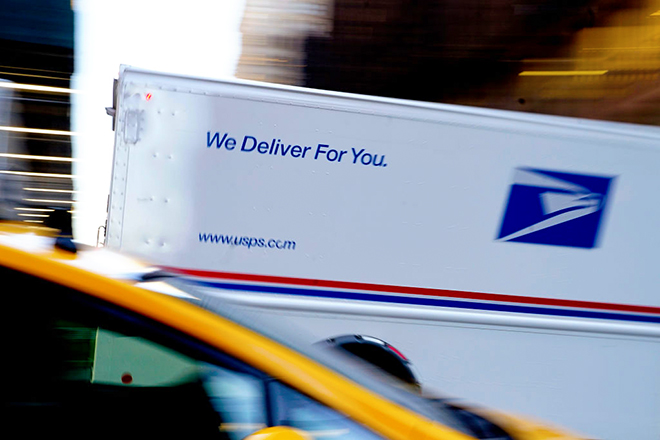
| A U.S. Postal Service truck travels along a New York City street. The Biden administration and Democratic lawmakers are pushing back on a U.S. Postal Service plan to replace only a small portion of the agency's fleet with electric vehicles. Source: Contributor/Corbis News |
The Biden administration, Congressional Democrats and clean transportation advocates are fighting a U.S. Postal Service plan to replace the agency's vehicle fleet in the next decade largely with gasoline-powered vehicles — a proposal that could undermine U.S. President Joe Biden's efforts to electrify the transportation sector and decarbonize federal government operations.
In a final environmental impact statement, released in January, the Postal Service proposed to buy 50,000 to 165,000 next-generation delivery vehicles to replace existing vehicles nationwide. Up to 90% of new purchases would be powered by internal combustion engines, or ICEs, with electric vehicles representing as little as 10% of the replaced fleet.
However, the agency's preferred plan would permit a higher percentage of EV purchases "should additional funding become available."
The Postal Service, an independent agency headed by a Trump-era appointee, said its plan is the "most achievable" given the Postal Service's delicate financial condition, asserting that electric battery-powered vehicles have a significantly higher total cost of ownership than new gasoline-powered ones. The EIS estimated that changing the order to require 75,000 of the new vehicles to be EVs would cost an additional $2.3 billion and that requiring 165,000 new vehicles to be EVs would add another $1 billion to the tab.
In February 2021, the Postal Service awarded a contract to Oshkosh Defense LLC to produce a vehicle that can support two powertrain alternatives — an internal combustion engine or batteries. In its final EIS, the agency said the contract would "support the production of both vehicle types in parallel" and that the Postal Service could order whatever mix of ICE vehicles or EVs it desires.
Plan draws blowback
Despite those assurances, the proposal drew protests from Biden administration officials and the president's Democratic allies in Congress.
In a Feb. 2 letter, EPA Associate Administrator Vicki Arroyo described the Postal Service's final EIS as "seriously deficient" because it did not disclose essential cost information and failed to consider "more environmentally protective feasible alternatives," among other issues.
The letter also criticized the Postal Service for awarding the contract to Oshkosh Defense and providing as much as $482 million under that deal without doing a full analysis of potential impacts as required under the National Environmental Policy Act. Arroyo asked the Postal Service to revise significant portions of the EIS and make it available for public comment and hearing.
"The Postal Service manages the largest single segment of the federal fleet, with nearly half of the federal civilian vehicles," the letter stated. "Electrification of only 10 percent of the Postal Service replacement vehicles ... falls far short of our national goals for reducing [greenhouse gas] emissions."
Advocacy group the Zero Emission Transportation Association disputed several key pieces of the final EIS. The group challenged the Postal Service's assertion that electric mail trucks would have a higher total cost of ownership, pointing to an independent analysis that suggested full electrification could save the agency $4.3 billion in lifetime costs compared with ICE vehicles.
The group also said the Postal Service underestimated the potential distance range for EVs, likely future gasoline prices and carbon dioxide emissions from a 90% ICE fleet. Also of note, the USPS estimated that the new ICE vehicles would only get 8.6-14.7 mpg compared with the 17 mpg of the 1988 Grumman vehicle in service now.
A bicameral group of 19
If the Postal Service does not follow through on the EPA's recommendations, the lawmakers will "urge the Administration to take any strong steps available to it, in order to remedy these issues," the letter stated.
Postal Service response
On Feb. 6, the Postal Service issued a lengthy statement saying it was committed to working with stakeholders, including Congress and the EPA, as it implements its next-generation vehicle program. An agency spokesperson, however, declined to say whether the Postal Service might revisit parts of its final EIS and invite public comment on any changes.
"Given our large fiscal deficits and significant financial challenges, Congress is well aware of the additional resources that would be required if Congress would prefer the Postal Service to accelerate the electrification of our delivery vehicle fleet," DeJoy said in the statement.
The Postal Service also emphasized that its cost estimates for the vehicle program include the price of charging infrastructure at agency facilities rather than assuming the availability of public charging.
In fiscal year 2021, the Postal Service suffered a net loss of $4.9 billion despite a more than 5% increase in operating revenue, reflecting the agency's requirement to pre-fund employee retirement healthcare benefits. This week, the U.S. House of Representatives is considering legislation that would free the Postal Service of those pre-funding obligations, saving the agency about $46 billion over 10 years.
The bill does not contain funding to electrify the agency's vehicle fleet. But given the potential cost savings from switching to EVs, "we just don't think that USPS' claims that they're in a dire financial situation, and therefore can't afford to electrify, holds all that much water," Zero Emission Transportation Association spokesperson Connor Morgan said in an interview.
The Postal Service could have issued a record of decision on its proposal Feb. 6 and begun procuring vehicles, but the agency indicated it would wait until Feb. 14, according to Morgan. With that extra time, the Zero Emission Transportation Association is trying to garner more support from Congress and the administration to get the Postal Service to change course.
Electrifying the Postal Service's vehicles would "send such a clear market signal that the United States government is in favor of electrifying the federal fleet," Morgan said. "Those investments ... are going to galvanize the further expansion of electrifying the transportation system, which of course will have huge implications for utilities."



